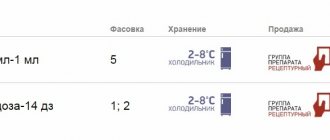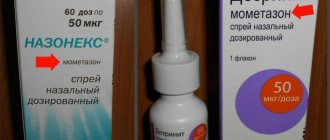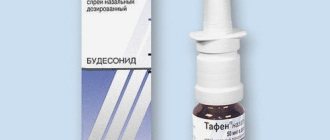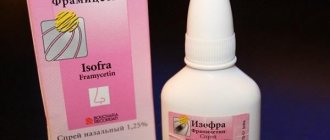pharmachologic effect
The hormone produced by the C-cells of the thyroid gland is an antagonist of parathyroid hormone and, together with it, participates in the regulation of calcium metabolism in the body.
The structure of all calcitonins is represented by one chain of 32 amino acids and a ring of 7 amino acid residues at the N-terminus, the sequence of which varies in different species. Since salmon calcitonin has a higher affinity for receptors (compared to mammalian calcitonins), its effect is most pronounced in both strength and duration.
By inhibiting osteoclast activity through its action on specific receptors, salmon calcitonin significantly reduces the rate of bone turnover to normal levels in conditions with an increased rate of resorption, such as osteoporosis.
In both animals and humans, Miacalcic to have analgesic activity for pain of bone origin, which appears to be due to a direct effect on the central nervous system.
Already after a single use of Miacalcic , a person experiences a clinically significant biological response, which is manifested by an increase in urinary excretion of calcium, phosphorus and sodium (due to a decrease in their tubular reabsorption) and a decrease in the excretion of hydroxyproline.
With long-term (5 years) use of Miacalcic, a significant and persistent decrease in the level of biochemical markers of bone metabolism, such as serum C-telopeptides (sCTX) and bone isoenzymes of alkaline phosphatase, is achieved.
The use of Miacalcic leads to a statistically significant increase (by 1-2%) in bone mineral density in the lumbar vertebrae, which is determined already in the first year of treatment and lasts up to 5 years. Miacalcic ensures the maintenance of mineral density in the femur.
Use of Miacalcic at a dose of 200 IU/day. leads to a statistically and clinically significant reduction (by 36%) in the risk of developing new vertebral fractures in the group of patients receiving Miacalcic (in combination with vitamin D and calcium preparations) compared to the group of patients receiving placebo (in combination with the same drugs) . In addition, in the group treated with Miacalc (in combination with vitamin D and calcium preparations), compared with the group receiving placebo (in combination with the same drugs), there was a 35% decrease in the incidence of multiple vertebral fractures.
Calcitonin reduces gastric and exocrine pancreatic secretion.
What is calcitonin
Peptide hormone is produced by parafollicular neuroendocrine cells (C cells) of the thyroid gland. Its functions are reduced to reducing the concentration of phosphorus and calcium ions in the bloodstream.
The level of thyrocalcitonin depends on the physiological state of the body. If a person is healthy, then the amount of calcitonin in his test data will be minimal. Conversely, the indicator deviates from the norm upward during acute inflammation.
Calcitonin is a tumor marker for a rare hormonally active malignant neoplasm of the thyroid gland (medullary cancer). A positive test result is further confirmed by ultrasound and fine needle aspiration biopsy.
In certain categories of people (newborns, pregnant and lactating women), calcitonin levels are always elevated.
Pharmacokinetics
Since radioimmunoassay methods used to date in pharmacokinetic studies are characterized by inadequate sensitivity and uncertain specificity, the pharmacokinetic parameters of salmon calcitonin administered intranasally are difficult to quantify.
Suction
Salmon calcitonin is rapidly absorbed through the nasal mucosa and its Cmax in plasma is reached within the first hour. Bioavailability for intranasal use is 3-5% relative to the bioavailability of the drug used parenterally. When using the drug in doses higher than recommended, the concentrations of the active substance in the blood were higher (which was confirmed by an increase in AUC), but the relative bioavailability did not increase.
Determining the concentration of salmon calcitonin in plasma, as well as the concentrations of other polypeptide hormones, seems to be of little value, since the level of concentrations cannot predict the therapeutic effectiveness of the drug. Thus, the activity of Miacalcic spray should be assessed according to clinical indicators of effectiveness.
Distribution
Salmon calcitonin does not cross the placental barrier in humans.
It is unknown whether salmon calcitonin passes into human breast milk.
Removal
T1/2 is 16-43 minutes. With repeated prescriptions of the drug, no accumulation of the active substance was observed.
Are deviations in analysis dangerous?
A slightly elevated level of calcitonin in the blood may be the first sign of a malignant neoplasm in the thyroid gland. Therefore, its concentration in the bloodstream must be checked periodically.
There are cases when upward deviations from the calcitonin norm are, on the contrary, welcomed by doctors. The peptide hormone increases in order to accelerate the recovery of injured tissues of internal organs.
A condition in which a prolonged decrease in calcitonin is accompanied by an increase in parathyroid hormone leads to hyperparathyroidism. The pathology is complicated by a hypercalcemic crisis, which is life-threatening. The patient has a temperature of 39-40°C, pain appears in the epigastric region, muscle weakness develops and the tissues of the internal organs swell. A person needs emergency medical care.
Indications
- treatment of postmenopausal osteoporosis;
- bone pain associated with osteolysis and/or osteopenia;
- Paget's disease of bone (osteitis deformans);
- neurodystrophic diseases (synonyms: algodystrophy or Sudeck atrophy), caused by various etiological and predisposing factors, such as post-traumatic painful osteoporosis, reflex dystrophy, glenohumeral syndrome, causalgia, drug-induced neurotrophic disorders.
Instructions for use / dosage
The drug is used intranasally.
For the treatment of osteoporosis, a dose of 200 IU/day is recommended. In order to prevent progressive bone loss, it is recommended to prescribe adequate doses of calcium and vitamin D simultaneously with the use of Miacalcic in the form of a dosed nasal spray. Treatment should be carried out over a long period of time.
For bone pain associated with osteolysis and/or osteopenia, the drug is prescribed daily at a daily dose of 200-400 IU. A daily dose of 200 IU can be administered at a time. Higher doses should be divided into several administrations. The dose should be adjusted to suit the individual needs of the patient.
It may take several days to achieve the full analgesic effect. When carrying out long-term therapy, the initial daily dose is usually reduced and/or the interval between administrations is increased.
For Paget's disease, the drug is prescribed daily at a daily dose of 200 IU. In some cases, at the beginning of treatment, a dose of 400 IU/day may be required, given in several doses. The duration of treatment is at least 3 months; if necessary it can be larger. The dose should be adjusted to suit the individual needs of the patient.
In Paget's disease, the duration of treatment with Miacalc should range from several months to several years. During treatment, there is a significant decrease in the concentration of alkaline phosphatase in the blood and the excretion of hydroxyproline in the urine, sometimes to normal values. However, in some cases, after an initial decrease, the values of these indicators may increase again. In these cases, the doctor, guided by the clinical picture, must decide whether treatment should be discontinued and when it can be resumed.
One or several months after discontinuation of treatment, bone metabolism disorders may recur; in this case, a new course will be required.
In neurodystrophic diseases, early diagnosis is extremely important. Treatment should begin immediately after confirmation of the diagnosis. Prescribe 200 IU/day. (in 1 administration) daily for 2-4 weeks. An additional dose of 200 IU is possible every other day for up to 6 weeks, depending on the dynamics of the patient’s condition.
Blood test for calcitonin: explanation
To determine the level of thyrocalcitonin in the bloodstream, one of two methods is used:
- Immunoenzymatic. The norm of the hormone calcitonin in women is 0.07-12.97 pg/ml, in men - 0.68-32.26 pg/mg. Children: no more than 70-79 pg/mg.
- Immunochemiluminescent. Normal values for males are up to 2.46 pmol/l, for females - up to 1.46 pmol/l.
The idea of a person’s health is formed taking into account the blood test data. If the level of thyrocalcitonin exceeds 100 units, it means that the gland is affected by medullary cancer. A biopsy is performed to confirm the diagnosis.
An upward deviation of the calcitonin value from the norm may indicate renal failure, pancreatitis, pernicious anemia, cirrhosis of the liver, benign neoplasm in the thyroid gland and a number of other diseases.
Side effect
The incidence of adverse events was assessed as follows: very often - ≥10%, often - from ≥1% to <10%, sometimes - from ≥0.1% to ≥1%.
Local: very often - rhinitis (including dryness in the nasal cavity, swelling and congestion in the nasal mucosa, sneezing, allergic rhinitis), nonspecific nasal symptoms (for example, soreness, formation of papules, excoriations, unpleasant odor, irritation, erythema); often - ulcerative rhinitis, sinusitis, nosebleeds. These phenomena are usually mild (about 80% of all reports) and require discontinuation of treatment in less than 5% of cases.
Systemic: often - hot flashes, dizziness, headache, nausea, diarrhea, abdominal pain, pain in bones and muscles, pharyngitis, fatigue, perversion of taste; sometimes - arterial hypertension, vomiting, joint pain, cough, flu-like symptoms, swelling (of the face, limbs, generalized edema), visual disturbances.
When using Miacalc, hypersensitivity reactions are possible, which can manifest as generalized skin reactions, hot flashes, swelling (of the face, limbs, generalized swelling), increased blood pressure, joint pain, itching. There have been reports of anaphylactoid-type reactions and isolated cases of anaphylactic shock.
Systemic adverse events are less common with intranasal than with parenteral use of Miacalcic .
Use during pregnancy and breastfeeding
Since studies have not been conducted in women during pregnancy and lactation, Miacalcic should not be used in this category of patients.
It is not known whether salmon calcitonin passes into breast milk in humans, therefore breastfeeding is not recommended during treatment with the drug.
In experimental studies conducted in animals, it was shown that Miacalcic does not have embryotoxic and teratogenic properties. It was found that in animals, salmon calcitonin does not penetrate the placental barrier.
special instructions
Since salmon calcitonin is a peptide, there is a potential for systemic allergic reactions. There are reports of allergic reactions, including isolated cases of anaphylactic shock, that occurred in patients receiving Miacalcic . If a patient is suspected of hypersensitivity to salmon calcitonin, skin tests should be performed before starting treatment with Miacalcic .
With long-term therapy, the formation of antibodies to calcitonins is possible, but this, as a rule, does not affect the clinical effectiveness. The habituation phenomenon, which is observed mainly in patients with Paget's disease receiving long-term therapy, may be a consequence of saturation of binding sites and is apparently not related to the formation of antibodies. The therapeutic effect of Miacalcic is restored after a break in treatment.
Use in pediatrics
Experience with the use of Miacalcic in children is limited, and therefore it is not possible to make recommendations for this age group.
Use in elderly patients and certain patient groups
Extensive experience with the use of Miacalcic in elderly patients indicates that in this age group there was no deterioration in tolerability of the drug or the need to change the instructions for use / dosage. The same applies to patients with decreased kidney or liver function, although studies have not been conducted specifically for these groups of patients.
Impact on the ability to drive vehicles and operate machinery
Considering the possibility of dizziness, as well as an increase in blood pressure during the use of Miacalcic , we cannot exclude the possibility of a negative effect of the drug on the rate of reactions. When using the drug, it is recommended to be careful when driving a car and operating machinery.
What additional diagnostic methods are required?
If the results of a biochemical analysis show that calcitonin is elevated, then most often the patient is prescribed additional examinations:
- Doppler ultrasound - to identify pathological neoplasms in internal organs (the thyroid gland, lungs, kidneys are examined).
- Biopsy - to determine the origin of the tumor.
- Serum calcium level test to confirm hyper- or hypofunction of the parathyroid glands.
To differentiate medullary cancer from hyperplasia, Riedel's goiter (an overgrowth of the connective tissue of the thyroid gland) or another disease, a histological analysis of a pathological tissue sample is performed.
Overdose
Symptoms: with parenteral use of Miacalcic , nausea, vomiting, hot flashes and dizziness are dose-dependent. Therefore, with an overdose of Miacalcic nasal spray, similar phenomena can be expected. However, there are reports of cases where Miacalcic nasal spray was used at a dose of up to 1600 IU once and at a dose of 800 IU / day. for three days, and no serious adverse events were noted. There are reports of isolated cases of overdose. In case of overdose, hypocalcemia may develop with symptoms such as paresthesia and muscle twitching.
Treatment: symptomatic therapy is carried out; if hypocalcemia develops, administration of calcium gluconate is recommended.









